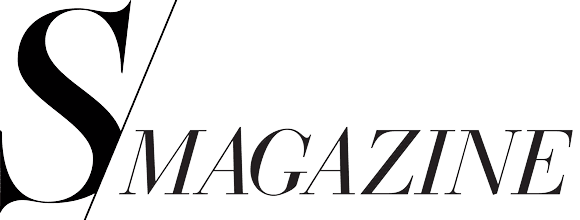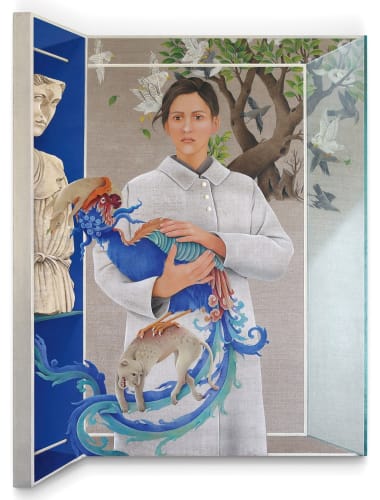
The word “empowerment” is losing its meaning becoming a buzzword used to sell everything from lipstick to yogurt. But for Tehran-born, Brooklyn-based artist Arghavan Khosravi, it’s a way to move forward. “I’m not interested in perpetuating notions of cultural exoticism and portrayals of Iranian women as victims,” she explains. “Rather, my work is a vehicle for shifting power, validating personal storytelling, and connecting to universal messages about human rights.” Her paintings, mainly acrylic on found textiles, have a surrealist quality, telling stories of her personal and political experiences.
Khosravi has been creating art since she was a young child, but began taking it more seriously at age 12 when she was enrolled in a two-year drawing and painting class. For her high school major, she chose mathematics (“Back then, I thought I should be more pragmatic and pursue an engineering degree in order to guarantee a job,” she says), but switched gears to study graphic design in college. She worked as a commercial graphic designer for a decade while completing an MFA in illustration from the University of Tehran and illustrating children’s books on the side. “Neither of those fields fully satisfied my desire to be creative and express my ideas freely. There was always a client or a writer and publisher I had to listen to. And on top of that, there was the general censorship in Iran,” she says. In 2015, Khosravi made the bold decision to pursue painting full-time. She moved halfway around the world to the United States, completing a post-baccalaureate in studio art at Brandeis University and an MFA in painting from the Rhode Island School of Design.
Prompted by the US’s 2017 ban on travelers from eight countries— six of which were majority-Muslim nations, including Iran—Khosravi started employing fabric as a canvas. “I was using my anger as fuel in my studio, but the blank canvas was intimidating. I had this idea to paint on pages of my expired passport and weave my narrative into the visual structure that was already there,” she explains. Eventually, the pages of her passport felt limited to this particular political moment, so Khosravi began experimenting with other backdrops, using found images as a starting point to activate her imagination and eventually landing on found textiles. “First, I used some textiles that I found here, in the United States, just to see how I could apply paint, and after a couple of paintings, I asked my father to send textiles from Iran. Because of their connection to my background, they arrived already culturally loaded.”
Her paintings—which are most often of women and explore themes of freedom of expression, power dynamics between genders, suppression, identity, and self-censorship, alluded to by imagery of veils, rope, and obscured faces—have found Khosravi a global audience. She has upcoming shows at M+B Gallery in Los Angeles, the Rachel Uffner Gallery in New York, and at Carl Kostyál in Milan. She takes a thoughtful approach to her pieces, always painting from fully formed ideas. “It can have a specific narrative, or it just can convey a mood or feeling. It mostly reflects on a memory, life event, a current event, or something I have recently read,” she says of her starting point. For Khosravi, time in the studio is not only a creative outlet, it’s an emotional journey. “Painting has a meditative quality for me, which helps me to cope with those feelings and channel them into art.”

